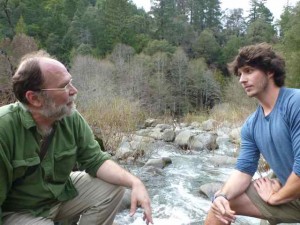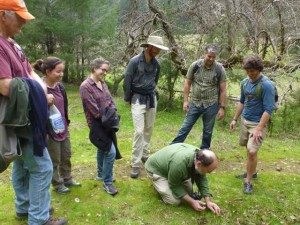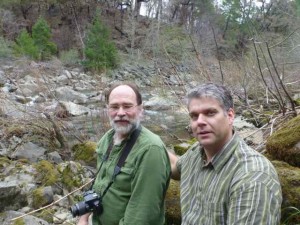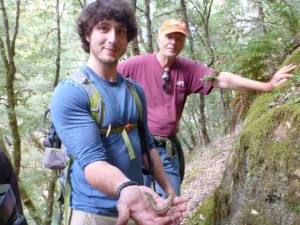
On March 13-15 2015, Joel Brown (University of Illinois, Chicago), Jim Estes (UC Santa Cruz), and Justin Brashares and Mary Power (UC Berkeley) and five graduate students from the Power and the Brashares labs got together at Angelo to discuss behavioral, evolutionary, and community ecology, and our shared interest in animal foraging and food webs. Joel and Mary discussed plans (that they first started hatching over 10 years ago) for a future short field course on “Landscapes of Food and Fear”. Animals (and plants and microbes) must forage for resources that are scattered around a shifting, heterogeneous environment. As food availability varies, so too do hazards from predators and environmental stresses that foragers experience (e.g. temperature, wind). Foraging by any organism involves trading off the gains to be made by collecting food against the costs of doing so—“how to find lunch without becoming lunch”, as yet another food web ecologist, Mark Hay of Georgia Tech puts it. Food gradients and the ability of animals to harvest resources can be studied experimentally, but how do we assess the perception of risks held by creatures very different from ourselves?


Joel, an evolutionary behavioral ecologist, has come up with a way to measure “the landscape of fear” for a wide range of animals. He reasoned that foragers should deplete food patches more thoroughly in areas they consider safe, where they could spend more time, and more of that time eating versus being vigilant. In patches they perceived as more dangerous, they might give up earlier, leaving behind more food. If food densities at various sites were initially similar before foraging occurred, the “Giving Up Density” (GUD) of food at a site after an animal quite foraging there might indicate how risky it considered that particular landscape position to be. Joel has devised ingenious experimental food patches tailored for particular types of animals (for example, squirrels get trays of sand mixed with fixed number of hidden nuts). standardized These patches can then be deployed along gradients of safety (e.g., for a squirrel, at the foot of a tree versus far from it). Joel and others have found that GUDs are good indices of how different species perceive their “Landscape of Fear”, and that you can learn a lot about how different species make the food-safety tradeoff that is relevant to their ecology, evolution, and potential futures on our changing planet.





Some time in late spring 2017 or 2018 we hope to host Joel for a Landscape of Food and Fear workshop at Angelo–stay tuned. Part of the fun for participants will be to devise Joel-inspired “food patches” with simple materials that can show how diverse creatures (grasshoppers, ground squirrels, garter snakes, butterflies, deer) perceive hazard and opportunity along gradients and across thresholds in their environments. Making successful food patches for a given species requires 1) that you attempt to “get inside the head” of your focal organism, and 2) that you enjoy the arts and crafts of ingenious field gear innovation that is a big part of successful experimental field ecology. Both are great fun.
